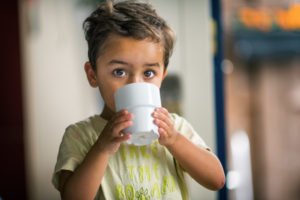
Tea contains caffeine, although its total content varies depending on the type of tea.
Pregnant women are advised to limit or totally stop their caffeine intake, and the same goes for young children.
Caffeine is a psychoactive substance. Although legal, it’s still a drug.
People that take large amounts of caffeine per day may experience withdrawal symptoms when they stop consuming it.
Of course, caffeine isn’t as harmful as other drugs. But children have low body weight and their brain is still developing.
The American Academy of Pediatrics discourages caffeine intake for kids below 12 years, because there is insufficient data on what the long term effects might be.
Note that besides tea and coffee, chocolate also contains caffeine. That means that many foods like cakes, ice cream, cookies, etc., can have caffeine as well.
In general, the younger the child, the less advisable it is for him to ingest caffeine.
Canada, however, has guidelines for caffeine consumption in children:
“Health Canada recommends the maximum daily caffeine intake for children under 12 should not exceed 2.5 mg/kg of body weight. Based on average body weights of children, this means a maximum of:
- 45 mg for children aged four to six, about one 355ml can of cola
- 62.5 mg for children aged seven to nine, about one and a half 355ml cans of cola
- 85 mg for children aged 10 to 12, nearly two 355ml cans of cola”
In terms of sencha, for example, 45 mg of caffeine would be about 6 oz (180 ml).
In general, people often say that from 5 years onwards a child can start drinking coffee or tea with moderation.
Houjicha is a good choice. It is almost decaffeinated and normally that is the tea that children drink in Japan.
How I have introduced tea to my daughter
When she was a toddler, I would let her smell the dry and wet tea leaves, but not drink it. This was mostly green tea.
From age four she was allowed to taste a few sips each day.
Right now she can drink about two ounces.
She has tried most types of Japanese green tea, and with some help she can prepare them as well 🙂

July 22, 2020
Nice article!
Can you elaborate more on caffeine content in Houjicha? I read research papers that claimed they houjicha has exactly same caffeine content as tea its made from.
July 22, 2020
Hi Areek
I wrote about that in this post:
https://www.myjapanesegreentea.com/why-is-houjicha-low-in-caffeine
Yes, I have suspected that the reason houjicha is low in caffeine is because it is often made with bancha, which is naturally low in caffeine. And unless it is a high grade houjicha, it usually contains more stems than bancha itself.
July 23, 2020
Here in Japan, most kids start off with mugicha (barley tea.) A great non-caffeine to introduce kids to tea.
July 24, 2020
Hi Kyle.
Mugicha is very popular, but I didn’t mention it because it’s a tisane. It doesn’t come from the tea plant.